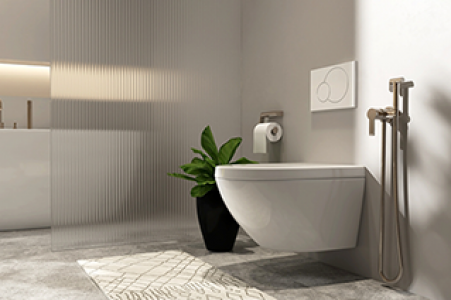
Potty Priorities: How to Pick the Perfect Toilet for You and Your Home
Toilets may not be the most glamorous home purchase, but they undoubtedly play a crucial role in our lives. As a fixture used several times a day, selecting the proper toilet is a decision that shouldn't be taken lightly.
With various considerations such as cost, water efficiency, cleanliness, and comfort, finding the perfect porcelain throne becomes a quest for the optimal balance.
What’s Your Priority?
Every homeowner cares about different things when it comes to their toilet. What’s at the top of your list?
1. Save Money
Traditional gravity-flush toilets take the lead when it comes to lower purchase prices and widely available options. These toilets operate on the principle of gravity, using the weight of the water to push waste down the drain.
Since gravity-fed toilets use a simple operating process with few components, they tend to have the fewest mechanical issues, and the flushing process is quiet.
Most gravity-fed toilets use a two-piece design that separates the tank from the bowl, which makes them easier to manufacture and transport. One-piece models are also available but are generally more expensive than their two-piece counterparts.
You can find gravity-flush toilets in various retail outlets, making them accessible and budget-friendly for most homeowners.
2. Use Less Water
One significant downside of older gravity-fed toilets is that they tend to use more water per flush compared to newer water-efficient models, which drives up the cost of USING your toilet. Case in point: The EPA says upgrading to a new toilet with its WaterSense label can save nearly 13,000 gallons of water yearly!
For environmentally-conscious homeowners looking to reduce water usage even more, low-flow and dual-flush toilets take traditional gravity-flush toilets a step further.
Some of the earliest low-flow models manufactured in the 1990s had issues with flushing power, leading to an increased risk of clog and more double flushing. However, modern versions have primarily addressed these concerns.
In contrast, dual-flush toilets provide two flushing options for liquids or solids so you can control your water usage based on the type of waste. These toilets typically have a higher upfront cost compared to standard toilets.
3. Easy to Clean
Cleaning a toilet is a household chore no one enjoys, but choosing the right toilet design can make this task more manageable. Opt for toilets with smooth surfaces and minimal nooks and crannies, reducing the areas where messes can accumulate.
One-piece toilets can be easier to clean and maintain with a seamless design and no gaps between the tank and the bowl.
Some of the newest toilets claim to have self-cleaning features. However, buyers should weigh the value and effectiveness of these features against their additional costs.
4. Reduce Clogs
A pressure-assisted toilet may be able to save you from the headaches of frequent plunging.They’re designed to handle waste more efficiently by utilizing compressed air to enhance the flushing process, which helps prevent clogs and reduces water usage.
Additionally, the extra force can make it harder for waste to adhere to the bowl, potentially reducing the need to clean as often. While these toilets have a higher upfront cost, their clog prevention and water conservation benefits may outweigh the initial investment.
On the downside, the flushing mechanism in pressure-assisted toilets can be louder than in gravity-flush toilets. These units don’t have many moving parts and are unlikely to break down. But if they do, it may be harder to find replacement parts at your local hardware since they are used in fewer homes.
5. Comfort
Who says you can't prioritize comfort when it comes to toilets? Many modern toilets are designed to be more comfortable, with features like ergonomic seating, elongated bowls, and chair-height designs.
Toilets with elongated bowls offer a larger seating area, providing additional comfort and a more modern, stylish look.
Toilets with a higher seat, often called chair height, are frequently more accessible, especially for adults with mobility issues.
Soft-close toilet seats add a touch of luxury, preventing slamming and reducing wear and tear. And regarding luxury, features like a heated toilet seat add another indulgence, typically reserved for those with higher budgets.
6. Works in a Small Bathroom
In compact spaces like half-baths or small guest bathrooms, choosing a toilet that can accommodate space limitations is essential. Round-bowl and wall-mounted toilets are two excellent options catering to space constraints.
Round-bowl toilets are simple and cost-effective. On the other hand, wall-mounted toilets are pricier and more complicated to install but create a sleek appearance by exposing the floor below. For homeowners valuing aesthetics in tight spaces, the investment in a wall-mounted toilet may be worthwhile.
7. Kid-Friendly
A kid-friendly toilet can make a significant difference if you have little ones at home. Consider round-bowl toilets with soft-close seats to prevent accidental injuries, and opt for a lower seat height for easy access.
Some toilets even have built-in potty training seats that can be lifted or lowered. Making the bathroom environment more accommodating for children simplifies daily routines and fosters independence.
8. Personal Hygiene
For those who prioritize personal hygiene, bidet seats or integrated bidet toilets are an excellent choice that provide a more thorough and hygienic cleansing experience than toilet paper alone.
Some advanced models even come with adjustable water temperature and pressure settings, ensuring a personalized and comfortable cleansing experience. Investing in a toilet that prioritizes personal hygiene can be a game-changer for your daily routine.
The toilet may not be the star among home fixtures, but its role is undeniable. By understanding your priorities and considering the various features available, you can select the perfect potty. Happy flushing!
